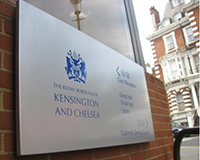A planning permission granted by the Royal Borough of Kensington & Chelsea under its controversial basements policy has survived an attack at the Planning Court, meaning the owner of a multi-million-pound property in Notting Hill can carry out the subterranean development.
In January, the authority approved a single-storey basement at 26 Portland Road, London W11 – which sold for more than £4m in 2015 – on an application by Jorge Manon and Bertha Morales. However, neighbour Ronald Kent, joint owner of 24 Portland Road, challenged that decision, claiming that Kensington & Chelsea did so in breach of its own basements planning policy introduced in 2015.
Today though, Mr Justice Hickinbottom dismissed Kent’s case, rejecting claims the authority had relied on an erroneous construction of its basement development policy and failed properly to have regard to preserving or enhancing the character and appearance of the surrounding Norland and Ladbroke Conservation Areas.
Policy CL7 of Kensington & Chelsea’s consolidated local plan defines basement development as “the construction or extension of one or more storeys of accommodation below the prevailing ground level of a site or property”, and limits such development to one storey, save for possible exceptions on large sites.
This latest case focused on the meaning of “prevailing ground level”. Kent claimed that earlier extensions of number 26 – a four-storey rear-closet wing in 1967 and a wraparound conservatory in the 1990s – lowered the ground level, thus preventing the grant of permission for further subterranean development under the policy.
However, the judge said that Policy CL7 is “abundantly clear” when considered in context – it is designed to limit the adverse effects caused by the excavation and construction of basements.
He said: “Its purpose is not to prevent dwellings having more than one basement storey, but to restrict nuisance to neighbours by proscribing the excavation and construction of more than one such storey.”
He added that, while the works in 1967 and the 1990s each extended the footprint of the property, “neither arguably involved the building of a new basement storey” and so, on its true construction, Policy CL7 was not breached by the proposed development.
The borough had maintained that the earlier works carried out at number 26 did not constitute basement development, as they did not add a floor below the original level of the property. It argued that the development permitted by this planning consent will be the first time that any floor is added beneath the original property, and so the proposal does not conflict with its policy.
R (on the application of Kent) v Royal Borough of Kensington and Chelsea Planning Court (Hickinbottom J) 8 November 2016
Megan Thomas (instructed by Forsters LLP) for the claimant
Isabella Tafur (instructed by Tri-Borough Legal Services) for the defendant








